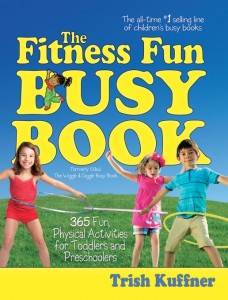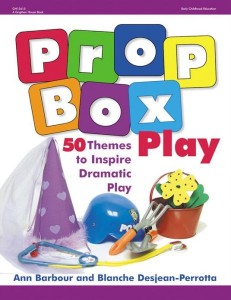Free play has gained a lot of attention lately. I’ve read about it in several places (here, here, here, here, and here). Documentary films have been made about it, the CDC has called attention to its health benefits, and psychologists have published articles about its importance to brain development and executive function.
Play must be important, right? How can we facilitate better play experiences for our children in Georgia’s PreK classrooms? Below are three books of ideas for outside time.
 The Fitness Fun Busy Book by Trish Kuffner
The Fitness Fun Busy Book by Trish Kuffner
From bn.com: The Fitness Fun Busy Book shows parents and daycare providers how to: instill a love of physical exercise through games and activities that encourage a child to move; focus a child’s energy constructively; encourage a child to strengthen large and small motor skills; connect music and rhyme with physical expression to develop a child’s creativity; and celebrate holidays and other special occasions with games and activities that get everyone moving.
 Big Body Play: Why Boisterous, Vigorous, and Very Physical Play Is Essential to Children’s Development and Learning by Frances Carlson
Big Body Play: Why Boisterous, Vigorous, and Very Physical Play Is Essential to Children’s Development and Learning by Frances Carlson
From bn.com: “Big body play”—the sometimes rowdy, always very physical running, rolling, climbing, tagging, jumping, grabbing, and wrestling that most children love and many adults try to shut down—can and should be an integral part of every early childhood setting. Drawing from evidence-based practice and the latest research, this book explains the multitude of benefits of big body play for young children’s social-emotional, cognitive, and physical development. Also learn how to organize the physical environment, set rules and policies, and supervise the play.
 Prop Box Play by Ann Barbour
Prop Box Play by Ann Barbour
From bn.com: Think inside the (prop) box! Encourage more dramatic play with Prop Box Play. Prop boxes contain dramatic play props that offer children the freedom to express themselves and to exercise their imaginations. Props that inspire children to play different roles (archeologist, veterinarian, undersea explorer) help them interact with each other, cultivating important social skills. Prop Box Play makes it easy for children to bring their imaginations to life!
Share your ideas and resources in the comments.
Possible GELDS Connections:
PDM1.4b Actively participates in a variety of both structured and unstructured indoor and outdoor activities for sustained periods of time that increase strength, endurance and flexibility.
PDM1.4c Consistently follows basic safety rules and anticipates consequences of not following safety rules.
PDM1.4d Communicates the importance of safety rules.
PDM3.4a Acts and moves with purpose and independently recognizes differences in direction, distance and location.
PDM3.4b Demonstrates spatial awareness through play activities.
PDM4.4a Discriminates between and identifies a variety of sights, smells, sounds, textures and tastes.
PDM4.4b Takes things apart and invents new structures using the parts.
PDM5.4a Coordinates movements to perform more complex tasks.
PDM5.4b Demonstrates coordination and balance in a variety of activities.
SED1.4b Identifies personal characteristics, preferences, thoughts and feelings.
SED1.4c Shows confidence in a range of abilities and the capacity to take on and accomplish new tasks.
SED1.4d Shows independence in his/her own choices.
SED3.4a Independently follows rules and routines.
SED3.4b Regulates own emotions and behaviors, and seeks out adult support when needed.
SED5.4a Develops and maintains friendships with other children.
SED5.4b Plays cooperatively with a few peers for a sustained period of time.
SED5.4c Attempts to resolve peer conflicts using appropriate strategies.
APL1.4a Takes initiative to learn new concepts and try new experiences. Initiates and completes new tasks by himself/herself.
APL1.4b Selects and carries out activities without adult prompting.
APL3.4a Engages in independent activities and continues tasks over a period of time.
APL3.4c Works cooperatively with others to successfully achieve a goal or accomplish a task.
APL3.4d Persists in trying to complete a task after previous attempts have failed.
APL4.4a Engages in elaborate and sustained imagined play, and can distinguish between real life and fantasy.
APL5.4a Willingly joins in sustained cooperative play and learning with others to complete a task.
APL5.4b Demonstrates flexibility in taking on various roles in a group setting.
APL5.4c Demonstrates inventiveness, imagination and creativity to solve a problem.
APL5.4d Considers a variety of possible solutions and exhibits flexibility if an alternate approach is suggested by a peer or adult.
APL5.4e Recovers quickly from setbacks and differences in opinion in a group setting.
CD-CP1.4a Recognizes cause- and- effect relationships.
CD-CP1.4b Explains why simple events occur using reasoning skills.
CD-CP1.4c Draws conclusions based on facts and evidence.
CD-CP2.4a Explains how to use objects in new situations.
CD-CP2.4b Uses observation and imitation to transfer knowledge to new experiences.
CD-CP2.4c Uses information gained about familiar objects and people, and can apply to a new situation.
CD-CP2.4d Makes, checks and verifies predictions.
CD-CP2.4e Explains how an activity is built on or uses past knowledge.
CD-CP3.4a Makes statements and appropriately answers questions about how objects/materials can be used to solve problems.
CD-CP3.4b Uses both familiar and new strategies to solve a problem.
CD-CP3.4c With adult guidance and questioning determines and evaluates solutions prior to attempting to solve a problem.


Leave a Reply